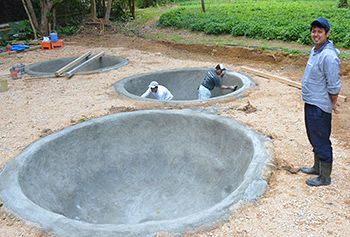Mikito Ikehara will make indigo dyes in prewar pots he found in Izumi

In Izumi, Motobu Town, Mikito Ikehara (right) has dug out indigo pots buried in the ground and repaired their walls.
May 15, 2018 Ryukyu Shimpo
By Maki Nagamine
Mikito Ikehara, an indigo dye artist from Izumi, Motobu Town who handles the refining of Ryukyu indigo, has begun practicing a traditional dyeing process by using pots presumably made before the war.
Three indigo pots that have been buried in the ground for at least 50 years were dug out in April this year.
Ikehara plans to start using them in the summer. He has been working with Ryukyu indigo for ten years.
He said, “I want to master these techniques and inherit traditional skills.”
An indigo pot is used to mix water and the Ryukyuai (Ryukyu indigo) leaves, and to extract pigment.
In the Izumi area, where indigo dye making was popular before the war, there were many indigo pots.
The three pots Ikehara dug out recently were in his Ryukyuai field in the mountain area of Izumi.
In the fall of 2016, Ikehara was looking for land to cultivate and found indigo pots buried in the ground.
He thought, “I want to make indigo dye with these,” and rented the land.
All of the pots are in the shape of bowls, in which plants and water are easy to mix.
They are each 3 meters in diameter and 1.3 to 1.4 meters in depth, with the capacity to hold about 4 tons of water.
After accumulated soils were removed from the pots, it was found that the bottoms were made of plaster, and there were traces of concrete used to repair the walls.
Yukari Owan, a curator at the Okinawa Prefectural Museum, said, “I think the indigo pots were made before the war.”
On April 4, Ikehara and his two friends from Izumi repaired the deteriorated walls.
Masanobu Teruya, who is a construction worker, said, “[Ikehara] does interesting things.” Ikehara thanked him and replied, “It’s because I have help from my local elders.”
Ikehara now manages three indigo fields and handles indigo dyeing and indigo mud making in his studio in Izumi.
He said that his number one reason for using the indigo pots made and used a long time ago is because he is curious about them.
Meanwhile, he is also determined to be involved in traditional industries in Okinawa.
He said, “I do things myself and gain experience through my failures.
Because I am involved in traditional things, I want to master these techniques and inherit traditional skills.”
(English translation by T&CT and Megumi Chibana)
Previous Article:US military proceed with vehicle air-drop training at Ie airfield despite calls to stop
Next Article:Yurika Nakamoto selected to represent Japan in Miss Supranational
[Similar Articles]
- Yoshimatsu Higa continues traditional cultivation and production of Ryukyu Dye into its 3rd generation
- Ryukyu indigo dye shortage threatens dye craftsmen
- Bite marks of dugong found close to Henoko relocation area
- Okinawa authorities view earthenware found in Henoko as cultural assets
- Governor Tamaki clarifies that the part of land reclamation announced as completed is only partially completed
 Webcam(Kokusai Street)
Webcam(Kokusai Street)


